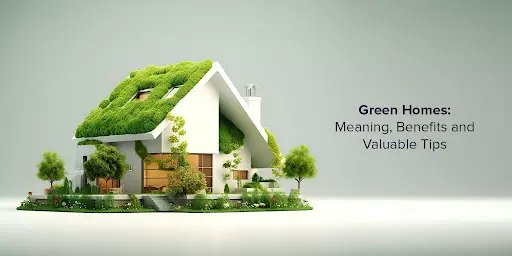Blog > Eco-Friendly Homes: What Buyers or Sellers Need to Know
With increasing awareness of environmental issues and the desire to reduce carbon footprints, eco-friendly homes have become a popular choice for both buyers and sellers. These homes are designed with sustainability in mind, offering benefits that go beyond environmental impact. Here’s what buyers and sellers need to know about eco-friendly homes:
What Makes a Home Eco-Friendly?
An eco-friendly home incorporates various sustainable practices and materials to minimize its environmental impact. Key features of eco-friendly homes include:
Energy Efficiency
Insulation: High-quality insulation reduces the need for heating and cooling, lowering energy consumption.
Windows: Energy-efficient windows help maintain indoor temperatures and reduce energy loss.
Appliances: Energy Star-rated appliances consume less electricity and water, leading to cost savings.
Renewable Energy Sources
Solar Panels: Solar panels generate electricity from sunlight, reducing reliance on fossil fuels.
Wind Turbines: In some regions, small wind turbines can supplement the home’s energy needs.
Geothermal Systems: These systems use the earth’s natural heat to regulate indoor temperatures.
Water Conservation
Low-Flow Fixtures: Faucets, showerheads, and toilets designed to use less water.
Rainwater Harvesting: Systems that collect and store rainwater for irrigation and other non-potable uses.
Greywater Systems: These systems recycle water from sinks, showers, and washing machines for use in irrigation or flushing toilets.
Sustainable Materials
Recycled and Reclaimed Materials: Using recycled or reclaimed materials reduces waste and environmental impact.
Sustainably Sourced Wood: Wood certified by the Forest Stewardship Council (FSC) ensures responsible forestry practices.
Low-VOC Paints: Paints with low volatile organic compounds (VOCs) improve indoor air quality.
Indoor Air Quality
Ventilation Systems: Proper ventilation systems remove indoor pollutants and improve air quality.
Non-Toxic Building Materials: Materials that do not emit harmful chemicals contribute to a healthier living environment.
Benefits of Eco-Friendly Homes
Environmental Impact
Eco-friendly homes reduce greenhouse gas emissions, lower energy consumption, and conserve water. By adopting sustainable practices, homeowners contribute to the preservation of natural resources and the reduction of their carbon footprint.
Cost Savings
While the initial investment in eco-friendly features may be higher, the long-term savings on energy and water bills can be substantial. Renewable energy sources like solar panels can significantly reduce electricity costs, and energy-efficient appliances and insulation lower utility expenses.
Health Benefits
Improved indoor air quality and the use of non-toxic materials create a healthier living environment. This can lead to fewer respiratory issues and allergies, enhancing overall well-being for occupants.
Increased Property Value
Eco-friendly homes are increasingly attractive to buyers, often leading to higher resale values. As more consumers prioritize sustainability, the demand for green homes is expected to grow, making them a wise investment for sellers.
Considerations for Buyers
Assessing Eco-Friendly Features
When evaluating a potential home, buyers should inquire about the specific eco-friendly features and certifications, such as LEED (Leadership in Energy and Environmental Design) or ENERGY STAR ratings. Understanding the extent of the home’s sustainability can help buyers make informed decisions.
Calculating Long-Term Savings
Buyers should consider the long-term savings associated with eco-friendly features. While the upfront cost may be higher, the reduction in utility bills and maintenance expenses can offset the initial investment over time.
Financing Options
Some lenders offer green mortgages or energy-efficient mortgage options that provide incentives for purchasing eco-friendly homes. Buyers should explore these financing options to make the investment more affordable.
Lifestyle Fit
Eco-friendly homes may come with certain lifestyle adjustments, such as learning to use renewable energy systems or adapting to water conservation practices. Buyers should ensure that these changes align with their values and lifestyle preferences.
Considerations for Sellers
Highlighting Eco-Friendly Features
Sellers should emphasize the eco-friendly features of their home in marketing materials. Highlighting benefits such as energy savings, health advantages, and environmental impact can attract environmentally conscious buyers.
Obtaining Certifications
Obtaining certifications such as LEED or ENERGY STAR can add credibility to the home’s eco-friendly claims. These certifications can make the property more appealing and justify a higher asking price.
Educating Buyers
Providing potential buyers with information on the benefits and operation of eco-friendly features can be helpful. Offering resources or manuals for renewable energy systems, water conservation practices, and sustainable materials can make the transition smoother for new homeowners.
Pricing Strategy
While eco-friendly homes can command higher prices, it’s essential to set a competitive and realistic asking price. Sellers should work with real estate agents experienced in green homes to determine the optimal pricing strategy based on market trends and demand.
Conclusion
Eco-friendly homes offer numerous benefits for both buyers and sellers, from environmental impact and cost savings to health advantages and increased property value. Understanding the features that make a home eco-friendly, the benefits, and the considerations for both buyers and sellers can help navigate the growing market for sustainable living. By prioritizing sustainability, homeowners can enjoy a healthier, more cost-effective, and environmentally responsible lifestyle, making eco-friendly homes a valuable and appealing choice in the real estate market.

